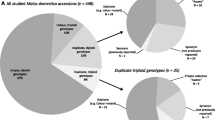Abstract
Inbreeding and coancestry coefficients were calculated for 20 apple (Malus × domestica Borkh.) cultivars released from Korea using their recorded pedigree information. The overall mean inbreeding coefficient was 0.034 for all 20 cultivars. Frequently used founding clones were ‘Grimes Golden’, ‘Delicious’, ‘Ralls Janet’, ‘Earli Blaze’, and ‘Esopus Spitzenburg’. Coefficients of coancestry among all 20 cultivars and the above mentioned five founding clones averaged 0.075, 0.075, 0.0075, 0.069, and 0.024, respectively. The average coancestry within the apple cultivars released from breeding program was 0.136 and mean coefficient ranged from 0.115 to 0.166, which is comparable to 0.125 for half-sib relationship. The redundant use of the same parents and their progenies can narrow the genetic base, thereby limiting genetic gain. Strategies are suggested for maintaining and increasing the genetic diversity, as well as for careful examining of pedigrees for future apple breeding in Korea.
Similar content being viewed by others
Literature Cited
Andersen, R.L. 1998. Current status of sweet cherry breeding. Acta Hort. 468:35–44.
Barr, A.J. 1983. The INBREED procedure, p. 121–130. In: S.P. Joyner (ed.). SUGI supplemental library user’s guide. SAS Institute, Cary, NC.
Brooks, R.M. and H.P. Olmo. 1972. Register of new fruit and nut varieties. 2nd ed. University of California Press, Berkeley.
Brooks, R.M. and H.P. Olmo. 1975. Register of new fruit and nut varieties list 30. HortScience 10:471–478.
Brooks, R.M. and H.P. Olmo. 1978. Register of new fruit and nut varieties list 31. HortScience 13:522–532.
Brooks, R.M. and H.P. Olmo. 1984. Register of new fruit and nut varieties list 34. HortScience 19:359–363.
Brooks, R.M. and H.P. Olmo. 1991. Register of new fruit and nut varieties list 35. HortScience 26:951–978.
Brooks, R.M. and H.P. Olmo. 1994. Register of new fruit and nut varieties list 36. HortScience 29:942–969.
Brown, A.G. 1973. The effect of inbreeding on vigor and length of juvenile period in apples. Proc. Eucarpia fruit section Symp. V. Top fruit breeding. p. 30–39.
Byrne, D.H. 1989. Inbreeding, coancestry, and founding clones of Japanese-type plums of California and the Southeastern United States. J. Amer. Soc. Hort. Sci. 114:699–705.
Choi, C. and F. Kappel. 2004. Inbreeding, coancestry, and founding clones of sweet cherries from North America. J. Amer. Soc. Hort. Sci. 129:535–543.
Crosby, J.A., J. Janick, P.C. Pecknold, S.S. Korban, P.A. O’Connor, S.M. Ries, J. Goffreda, and A. Voordeckers. 1992. Breeding apples for scab resistance: 1945–1990. Fruit Var. J. 46:145–166.
Dale, A., P.P. Moore, R.J. McNicol, T.M. Sjulin, and L.A. Burmistrov. 1993. Genetic diversity of red raspberry varieties throughtout the world. J. Amer. Soc. Hort. Sci. 118:119–129.
Falconer, D.S. and T.F.C. Mackay. 1996. Introduction to quantitative genetics. 4th ed. Longman Inc., New York.
Hancock, J.F. and J.H. Siefker. 1982. Levels of inbreeding in highbush blueberry cultivars. HortScience 17:363–366.
Heo, S., S.E. Han, S.I. Kwon, J.H. Jun, M.J. Kim, and H.J. Lee. 2011. Identification of S-allele genotypes of Korean apple cultivars by using allele-specific polymerase chain reaction. Hort. Environ. Biotechnol. 52:158–162.
Kim, D.I., T.M. Yoon, M.S. Yiem, I.J. Chun, and C. Choi. 2007. Apple, p. 188–203. In: J.M. Lee, G.W. Choi, and J. Janick (eds.). Horticulture in Korea. Korean Society for Horticulture Science, Suwon, Korea.
Korea Rural Economic Institute (KREI). 2011. Agricultural outlook 2011. KREI, Seoul, Korea p. 561–612.
Lansari, A., D.E. Kester, and A.F. Iezzoni. 1994. Inbreeding, coancestry, and founding clones of almonds of California, Mediterranean Shores, and Russia. J. Amer. Soc. Hort. Sci. 119:1279–1285.
Laurens, F. 1999. Review of the current apple breeding programs in the world: Objectives for scion cultivar improvement. Acta Hort. 484:163–167.
Morgan, J. and A. Richards. 1993. The book of apples. Ebury Press, London.
Noiton, D.A.M. and C.G.A. Shelbourne. 1992. Quantitative genetics in an apple breeding strategy. Euphytica 60:213–219.
Noiton, D.A.M. and P.A. Alspach. 1996. Founding Clones, Inbreeding, Coancestry, and Status Number of Modern Apple Cultivar. J. Amer. Soc. Hort. Sci. 121:773–782.
Roach, F.A. 1985. History and evolution of fruit crops. HortScience 23:51–55.
Scorza, R., W.B. Sherman, and G.W. Lightner. 1985. Inbreeding and coancestry of freestone peach cultivars of the eastern United States and implications for peach germplasm improvement. J. Amer. Soc. Hort. Sci. 110:547–552.
Shin, Y.U., W.C. Kim, S.J. Kang, J.Y. Moon, and J.H. Kim. 1989. ’Hongro’, high sugar, attractive red color apple cultivar for “Chuseok” season. Kor. J. Hort. Sci. Technol. 7:68–69.
Way, R.D., H.S. Aldwinckle, R.C. Lamb, A. Rejman, S. Sansavini, T. Shen, R. Watkins, M.N. Westwood, and Y. Yoshida. 1990. Apples. Acta Hort. 290:1–62.
Williams, E.B., J. Janick, and F.H. Emerson. 1967. Five scab-resistant apple selections released for grower testing. Purdue Univ. Agr. Expt. Sta. Bul. 271.
Williams, E.B., J. Janick, and F.H. Emerson. 1975. Co-op 12–18: Seven scab-resistant apple selections released for advance testing. Purdue Univ. Agr. Expt. Sta. Bul. 69.
Williams, E.B., J. Janick, F.H. Emerson, S.S. Korban, and D.F. Dayton. 1984. Co-op 23, 24, 25 and 26: Four scab-resistant apple selections released for advance testing. Purdue Univ. Agr. Expt. Sta. Bul. 456.
Yae, B.W. and K.C. Ko. 1995. Classification of Malus domestica cultivars by random amplified polymorphic DNA markers. J. Kor. Soc. Hort. Sci. 36:824–828.
Yamada, M. C. Suzuki, and M. Ishiyama. 1980. New apple variety ‘Tsugaru’. Bul. Aomori Apple Expt. Sta. 18:1–10.
Author information
Authors and Affiliations
Corresponding author
Rights and permissions
About this article
Cite this article
Son, K.M., Kwon, S.I. & Choi, C. Inbreeding, coancestry, and founding clones of apple cultivars released from Korea. Hortic. Environ. Biotechnol. 53, 404–409 (2012). https://doi.org/10.1007/s13580-012-0012-8
Received:
Revised:
Accepted:
Published:
Issue Date:
DOI: https://doi.org/10.1007/s13580-012-0012-8




